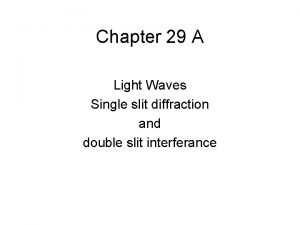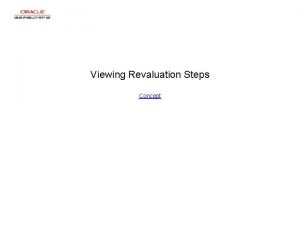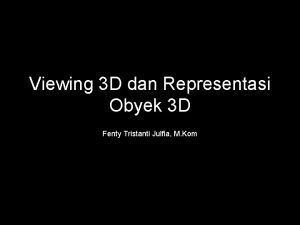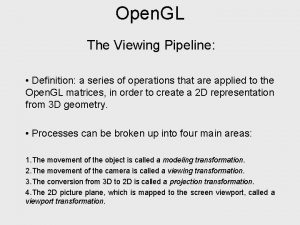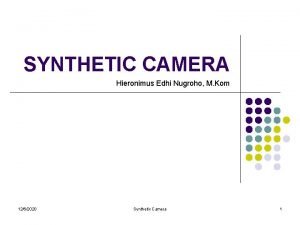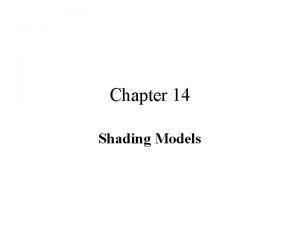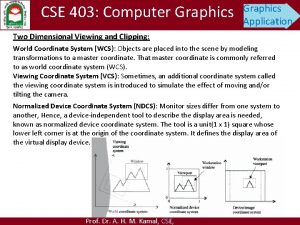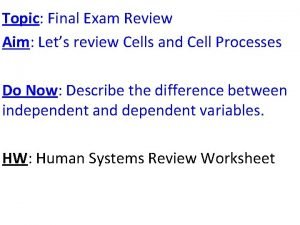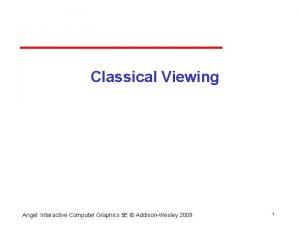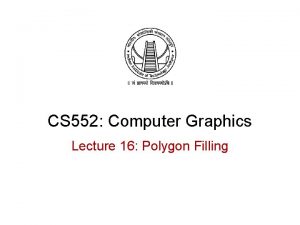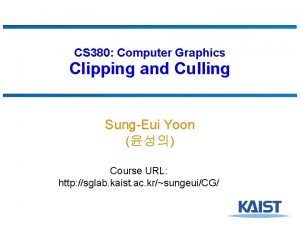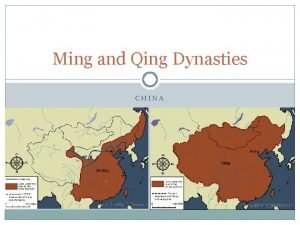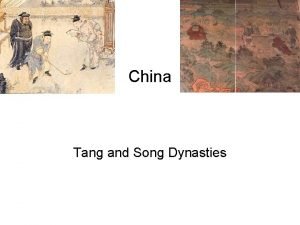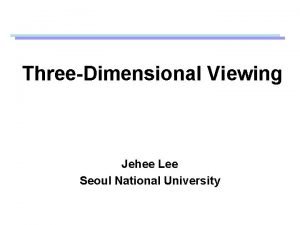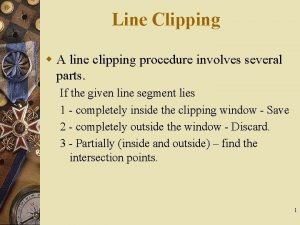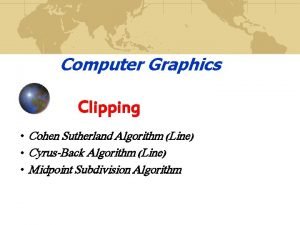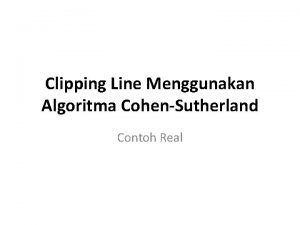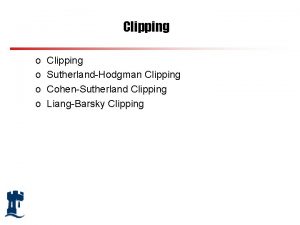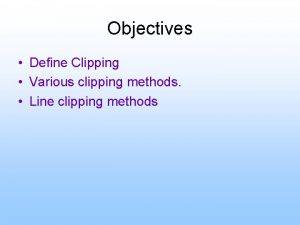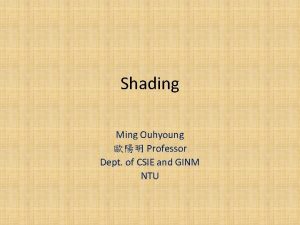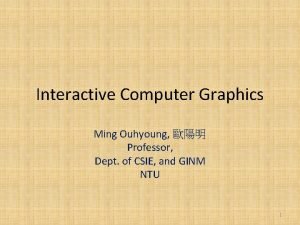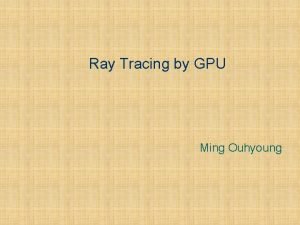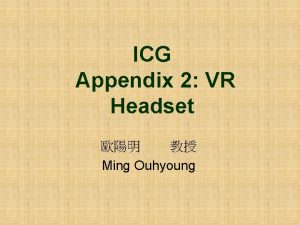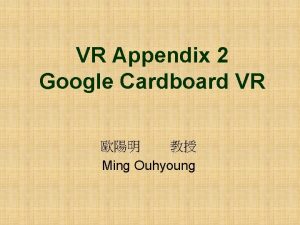3 D Viewing and Clipping Ming Ouhyoung Professor




































- Slides: 36

3 D Viewing and Clipping Ming Ouhyoung 歐陽明 Professor Dept. of CSIE and GINM NTU

3 D Viewing Process Clip against view volume 3 D world-coordinate output primitives Project onto projection plane Clipped world coordinates Transform into viewport in 2 D device coordinates for display 2 D device coordinates

Perspective Projection (Pinhole Camera, eye at origin ) x Projection plane P(x, y, z) xp z d View along y axis View along x axis d z y yp Projection plane P(x, y, z)

Perspective Division However W 1, so we must divide by W to return from homogeneous coordinates

Specification of an Arbitrary 3 D View v VUP VRP View plane VPN n • VRP: view reference point • VPN: view-plane normal • VUP: view-up vector u

Truncated View Volume for an Perspective Projection (how to do 3 D clipping? ), PRP: projection reference point, DOP: direction of projection Front Clipping plane View plane Back Clipping plane VRP VPN F B

PRP: Projection reference point

Clipping: 2 D & 3 D • 2 D against clipping window • 3 D against clipping volume • Easy for line segments polygons • Hard for curves and text Convert to lines and polygons first E. Angel and D. Shreiner: Interactive Computer Graphics 6 E © Addison-Wesley 8

Clipping: wireframe E. Angel and D. Shreiner: Interactive Computer Graphics 6 E © Addison-Wesley 2012 9

Clipping: surface E. Angel and D. Shreiner: Interactive Computer Graphics 6 E © Addison-Wesley 2012 10

Clipping 2 D Line Segments • Brute force approach: compute intersections with all sides of clipping window Inefficient: one division per intersection E. Angel and D. Shreiner: Interactive Computer Graphics 6 E © Addison-Wesley 2012 11

Cohen-Sutherland Algorithm • Idea: eliminate as many cases as possible without computing intersections • Start with four lines that determine the sides of the clipping window y = ymax x = xmin x = xmax y = ymin E. Angel and D. Shreiner: Interactive Computer Graphics 6 E © Addison-Wesley 2012 12

The Cases • Case 1: both endpoints of line segment inside all four lines Draw (accept) line segment as is y = ymax x = xmin x = xmax y = ymin • Case 2: both endpoints outside all lines and on same side of a line Discard (reject) the line segment E. Angel and D. Shreiner: Interactive Computer Graphics 6 E © Addison-Wesley 2012 13

The Cases • Case 3: One endpoint inside, one outside Must do at least one intersection • Case 4: Both outside May have part inside Must do at least one intersection y = ymax x = xmin x = xmax E. Angel and D. Shreiner: Interactive Computer Graphics 6 E © Addison-Wesley 2012 14

Defining Outcodes • For each endpoint, define an outcode b 0 b 1 b 2 b 3 b 0 = 1 if y > ymax, 0 otherwise b 1 = 1 if y < ymin, 0 otherwise b 2 = 1 if x > xmax, 0 otherwise b 3 = 1 if x < xmin, 0 otherwise • Outcodes divide space into 9 regions • Computation of outcode requires at most 4 subtractions E. Angel and D. Shreiner: Interactive Computer Graphics 6 E © Addison-Wesley 2012 15

Using Outcodes • Consider the 5 cases below • AB: outcode(A) = outcode(B) = 0 Accept line segment E. Angel and D. Shreiner: Interactive Computer Graphics 6 E © Addison-Wesley 2012 16

Using Outcodes • CD: outcode (C) = 0, outcode(D) 0 Compute intersection Location of 1 in outcode(D) determines which edge to intersect with Note if there were a segment from A to a point in a region with 2 ones in outcode, we might have to do two interesections E. Angel and D. Shreiner: Interactive Computer Graphics 6 E © Addison-Wesley 2012 17

Cohen Sutherland in 3 D • Use 6 bit outcodes • When needed, clip line segment against planes E. Angel and D. Shreiner: Interactive Computer Graphics 6 E © Addison-Wesley 2012 18

Clipping and Normalization • General clipping in 3 D requires intersection of line segments against arbitrary plane • Example: oblique view E. Angel and D. Shreiner: Interactive Computer Graphics 6 E © Addison-Wesley 2012 19

Two cameras: (b) back not parallel to the front E. Angel and D. Shreiner: Interactive Computer Graphics 6 E © Addison-Wesley 2012 20

Plane-Line Intersections Line p 1 p 2 = p 1 + t*(p 2 p 1) where 0<= t<=1 when t = a The intersection point E. Angel and D. Shreiner: Interactive Computer Graphics 6 E © Addison-Wesley 2012 21

Plane-Line Intersections: II E. Angel and D. Shreiner: Interactive Computer Graphics 6 E © Addison-Wesley 2012 22

Canonical View Volume for Perspective Projection: 3 D clipping is easier this way! x or y Back plane -z 1 Front plane -1 -1 • x = z, y = z, z = -zmin • x = -z, y = -z, z = -1

The Extension of the Cohen-Sutherland Algorithm • • • bit 1 – point is above view volume bit 2 – point is below view volume bit 3 – point is right of view volume bit 4 – point is left of view volume bit 5 – point is behind view volume bit 6 – point is in front of view volume y > -z y<z x > -z x<z z < -1 z > -zmin

Why simplified clipping? (by space transformation)

The Steps of Implementation of Perspective Projection • • • Translate the VRP to the origin Rotate VRC such that the VPN becomes the z axis Translate such that the PRP is at the origin Shear such that the DOP becomes parallel to the z axis Scale such that the view volume becomes the canonical perspective view volume

• Nper = Sper * SHper * T(-PRP) * R * T(-VRP) =T(0, 0, 0) where no oblique proj. T(-PRP) = T((0, 0, d)) • SHper=1, R=Ry(180 o)= [ -1 [ 0 [ 0 0 0 1 0 0 -1 0 0 0] 0] 0] 1]

• Sper(scaling)= • Assuming back clipping plane = (Umax, Vmax, B ) • Front clipping plane = (Umin, Vmin, Zmin = F) • For example, let Umax = 5 = Vmax, B=10, F=-d+2 Umin = -5 = Vmin, vrpz‘ = d, where d=8

Detailed derivation: step by step

Vanishing Points • Parallel lines (not parallel to the projection plan) on the object converge at a single point in the projection (the vanishing point) • Drawing simple perspectives by hand uses these vanishing point(s) vanishing point

Advantages and Disadvantages • Objects further from viewer are projected smaller than the same sized objects closer to the viewer (diminuition) – Looks realistic • Equal distances along a line are not projected into equal distances (nonuniform foreshortening) • Angles preserved only in planes parallel to the projection plane • More difficult to construct by hand than parallel projections (but not more difficult by computer)

Canonical View Volume for Orthographic Parallel Projection x or y Back plane -z 1 Front plane -1 -1 • x = -1, y = -1, z = 0 • x = 1, y = 1, z = -1

The Extension of the Cohen-Sutherland Algorithm • • • bit 1 – point is above view volume bit 2 – point is below view volume bit 3 – point is right of view volume bit 4 – point is left of view volume bit 5 – point is behind view volume bit 6 – point is in front of view volume y>1 y < -1 x>1 x < -1 z>0

Intersection of a 3 D Line • A line from represented as • So when y = 1 to can be

Intersection of a 3 D Line • So when y = z

Standard Graphics Pipeline
 Promotion from associate professor to professor
Promotion from associate professor to professor Claim of calue
Claim of calue Half sectional drawing
Half sectional drawing Film as text
Film as text Eccentric viewing techniques occupational therapy
Eccentric viewing techniques occupational therapy Slit diffraction
Slit diffraction Thank you for viewing my presentation
Thank you for viewing my presentation Steps in viewing
Steps in viewing Contoh viewing 3d
Contoh viewing 3d Define viewing pipeline
Define viewing pipeline Viewing coordinate sering juga disebut
Viewing coordinate sering juga disebut Bryanna and charles are in a dancing competition
Bryanna and charles are in a dancing competition Viewing pipeline
Viewing pipeline Define projection in computer graphics
Define projection in computer graphics Computer graphics introduction ppt
Computer graphics introduction ppt Normalized device coordinate
Normalized device coordinate Interior and exterior clipping in computer graphics
Interior and exterior clipping in computer graphics While viewing a slide of rapidly moving sperm cells
While viewing a slide of rapidly moving sperm cells Ground viewing driving
Ground viewing driving Viewing angel
Viewing angel Flood fill algorithm in computer graphics
Flood fill algorithm in computer graphics Periwig clipped word
Periwig clipped word Steer clipping and fitting techniques
Steer clipping and fitting techniques Clipping and culling
Clipping and culling Ming and qing dynasty
Ming and qing dynasty Qing dynasty location
Qing dynasty location Tang and song venn diagram
Tang and song venn diagram Line clipping
Line clipping Professor clipped word
Professor clipped word Whats morpheme
Whats morpheme Nicholl lee nicholl line clipping algorithm
Nicholl lee nicholl line clipping algorithm Back formation
Back formation Ppt
Ppt Active edge table in computer graphics
Active edge table in computer graphics Cohen-sutherland algorithm
Cohen-sutherland algorithm Contoh clipping adalah
Contoh clipping adalah Algoritma clipping
Algoritma clipping





